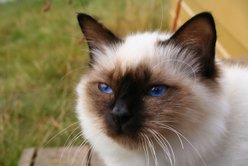

Custom Search
|
| Birman |
|---|

A sealpoint Birman's face
|
| Alternative Names |
| Sacred Birman |
| Country of origin |
| Burma or Thailand |
| Breed standards (external links) |
|
CFA,
ACFA,
TICA,
CCA, ACF, FIFe |
The Birman is a breed of domestic cat. This breed has a pale cream coloured body and coloured points of Seal, Blue, Chocolate, Lilac, Lynx or Red Factor colors on the legs, tail and face. The body type varies from Persian-type to Siamese-type. Birmans differ from conventional colour-point cats by their white paws called gloves. The coat is medium-length, not as long and thick as a Persian's, and does not mat.
The Birman is said to have originated in western Burma, and certainly cats with similar markings are recorded in documents from ancient Thailand. One story claims that a pair was given as a gift to an Englishman named Major Gordon Russell and his friend August Pavie by the priests of the Khmer people; another that the cats were acquired by an American named Vanderbilt from a servant who had once been at the temple of Lao-Tsun where the cats were kept as sacred animals. Two cats were shipped to France in approximately 1919. The male died in transit, but the female was pregnant and gave birth to a litter of kittens in France. These formed the basis of a breeding program and the breed was registered with the French Cat Registry in 1925. The Birman breed was almost wiped out during World War II. Only two cats were alive in Europe at the end of the war, and they had to be heavily outcrossed and rebred to rebuild the breed. The restored breed was recognised in Britain in 1965 and by the American Cat Fanciers' Association in 1966.
In reality modern western Birmans are a hybrid of Siamese and Persian breeds and may differ considerable from Burma temple cats from which they originally obtained their white gloves.
Cats, made by MultiMedia | Free content and software
This guide is licensed under the GNU Free Documentation License. It uses material from the Wikipedia.